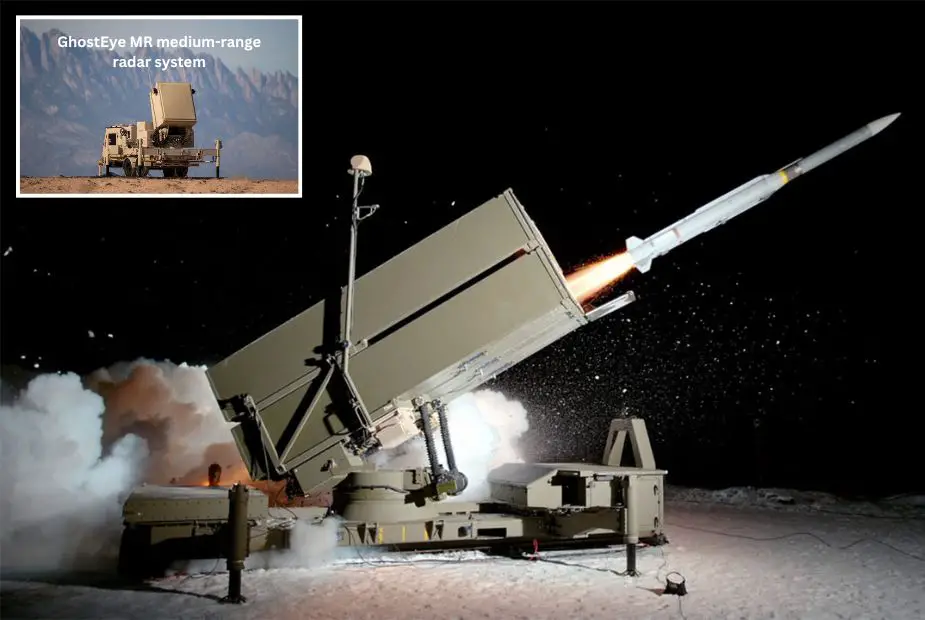Kongsberg Reveals Upgrades to NASAMS with AMRAAM-ER Missile and GhostEye MR Radar
Kongsberg, the Norwegian company, is currently engaged in upgrading the NASAMS anti-aircraft system by integrating a new AMRAAM-ER missile and the GhostEye MR radar system, specifically focusing on adding capabilities to intercept ballistic missiles. This development was first reported by the Norwegian media outlet Teknisk Ukeblad on April 22, 2024, citing internal sources from Kongsberg.
Follow Army Recognition on Google News at this link

The first flight test of the new AMRAAM-ER variant for the NASAMS system was carried out on 12 March 2024 (Picture source: Kongsberg Defence & Aerospace )
NASAMS is a medium to long-range air defense platform developed jointly by Kongsberg Defence & Aerospace and Raytheon (RTX). Designed to effectively counter various aerial threats such as aircraft, helicopters, drones, and cruise missiles, NASAMS combines advanced detection radars and ground-to-air missile launchers. The system is noted for its modularity and flexibility, allowing for the integration of various types of radars and missiles based on operational needs. Its open architecture and ability to be integrated into broader air defense networks make it a versatile solution for modern defense requirements.
The current versions of NASAMS are equipped to intercept aerodynamic targets such as aircraft, helicopters, and cruise missiles. However, to meet the requirements for intercepting ballistic targets, significant improvements are needed, particularly regarding the maximum interception altitude and speed of the guided anti-air missiles.
A key development is the integration of the new AMRAAM-ER air defense missile, which recently completed testing with the NASAMS system in February 2024. This missile is an upgraded version of the AIM-120C-8 missile and is equipped with a state-of-the-art guidance system featuring an active radar seeker and a significantly more powerful 10-inch rocket motor. This innovation provides the missile with increased speed and an extended range of 20 to 40 km.
Additionally, the GhostEye MR medium-range radar system has been successfully integrated into the system. This radar can detect targets such as cruise missiles, aircraft, and helicopters, and now also ballistic missiles. It uses technologies from the LTAMDS missile defense system, currently produced for the U.S. Army. The radar is equipped with a 360-degree rotating antenna and an S-band active phased array antenna using gallium nitride (GaN) transmission modules. The precise characteristics of this radar's aerial target detection capabilities remain unknown, but project participants suggest it will significantly extend NASAMS' range and altitude capabilities, replacing the current AN/MPQ-64 Sentinel radar. Despite these improvements, the missile capabilities are limited by the low power of their warheads, which may not be sufficient to inflict critical damage on missiles like the Iskander type.
Moreover, since November 2023, Kongsberg has been collaborating with the American company RTX to enhance the operational flexibility of NASAMS. Few details have been revealed about this collaboration, but it has been noted that the new version of the system will be mobile, thus increasing its adaptability in the field.
NASAMS has been adopted by several countries since it was introduced in the mid-1990s. The United States was among the first users, quickly followed by Norway, the system's country of origin. Other countries that have incorporated NASAMS into their arsenals include Spain, Finland, the Netherlands, and Australia, each deploying various numbers of units based on their specific defense needs. Since the onset of the war in Ukraine in 2022, several nations, including the United States and Norway, have provided NASAMS systems to Ukraine to bolster its air defense capabilities against Russian aggression.
Defense News April 2024
- Hits: 3364
















